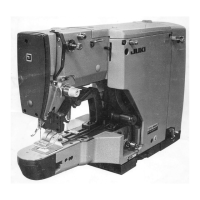(5) Precautions when sewing synthetic materials
When
synthetic or blend materials are sewnwith synthetic threads,
special
attention shouldbe paidto the
follow
ing
points;
1) Protection of the thread against overheating
If the thread or the material is melted by a
needle
heated by the frictional heat produced
between
the
needle
and the material, take the following preventive measures;
A.
Replace
the motor
pulley
with either
B7101-280-00C
(50 Hz) or
B7102-280-00C
(60 Hz)
designed
for
synthetic material applications at a sewingspeed
of
1,700 s.p.m.
B.
Use
the
silicon
oil
lubricator.
C. Usea needle for synthetic materials.
D. Use a
finer
needle
to
reduce
friction.
2) Thread becomes fluffy
If the thread
becomes
fluffywhenstitching,
move
the
frame
thread
guide
(A)to the left and
increase
the stroke
of
the thread take-up lever.
3) Starting stitches are loose.
If loose stitches are formed at the start of
sewing,
adjust the timing of the cloth feed. Follow the method of
stardard adjustment mentioned in I-(l) and adjust the feed cam so that the cloth feed action is completed when
the pointed end of the needle is still in position within the specified adjusting
range
and closer to 10 mm
(25/64").
4) The blades
of
the shuttle driver are scratched.
Synthetic threads tend to scratch the thread path surface whenit is
released.
Remove
suchscratches by buffing
the
surfaces.
5) Smoothness
of
the thread paths
All the thread paths on the following components must be smooth enough to allow the thread to pass without
friciton;
Shuttle
driver
B1813-980-000
Shuttle
B1818-280-000
Shuttle
race spring B1815-980-000
Needle plate needle hole guide B2426-280-000
Needle
bar
thread
guide B1405-280-000
(Note) Without exception, use a DP x 5 needle. Do not use LQ x 5 which has been used with the conventional
LK-232 model, because this needle may scratch the periphery
of
the needle hole in the needle plate,
which may cause thread breakage.
(6)
Loose
stitching
(1) Firm stitching is not formed.
1) Adjustment
of
the feed timing
To obtain tight stitches, adjust the feed cam according to the instructions given in I-(l) so that the cloth feed
actioniscompleted by the timethe pointedend of the
needle
comes
downto near 7 mm (9/32") in height.
2) Adjustment
of
tension controller No. 2 and the thread take-up spring
Increase the tensions
of
both
components.
(2) Overlappingstitching
1) Adjustment
of
the direction
of
the needle
Rotate
the
needle
by 5 to
10**
to the left
from
the
standard
direction.
Do not rotate it too'much, or
stitches
may be skipped. (Fig.
37)
Intersecting
Fig.
37
-
20
-

